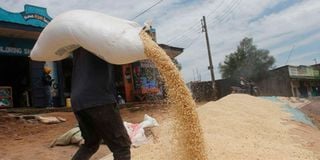Premium
Pain for farmers as maize yields drop in bread basket

A man spreads maize out to dry by the roadside in Elburgon town in Nakuru County on October 18. A 90-kilo bag is retailing at Sh2,600 ahead of this season’s harvest.
What you need to know:
- Shortage of agricultural extension officers, importation of cheaper maize and market instability driving the subsector to its knees.
- The unsteady market prices caused by importation of cheap cereals is driving many maize farmers out of the sub-sector.
Maize production in the North Rift region, the country’s bread basket, has sharply declined as farmers invest in other crops.
The Ministry of Agriculture estimates that there was a 20 per cent drop in harvests from 21 million to 16 million in the 2020 season due to various factors — ranging from erratic rainfall to substandard farm inputs and outbreaks of fall army worm, head smut and maize lethal necrosis.
According to agricultural experts, a shortage of agricultural extension officers, importation of cheaper maize and market instability is driving the subsector to its knees.
In Uasin Gishu, yields dropped from 4.4 million to 3.7 million bags in 2017 while in Trans Nzoia County the harvest declined from 5.3 million bags to 4.7 million bags, with experts blaming soil acidity and use of substandard fertiliser.
“I used to harvest an average of 30 bags per acre then but can hardly manage 20 bags now. Soil fertility has gone down while farmers are unable to access to information on modern crop production techniques from extension officials as was the case before,” Ms Hellen Kirarei, a farmer from Cheptiret in Uasin Gishu County, tells the Nation.
“The government needs to come up with effective policies on food security and curb the importation of cheap maize,” Ms Kirarei adds.
According to annual agriculture reports, total yields reduced from 27 million bags to 21 million bags in the 2013/2014 season and from 31 million bags in 2012/2013.
Reduced yields
Many of the agricultural extension officers have retired and are yet to be replaced due to lack of money for county governments to hire new ones, officials have told the Nation in confidence.
“One extension officer covers three to four locations unlike in the past when each sub-location had one,” says Mr Paul Lang’at, a private consultant in agricultural extension services in the North Rift region.
“Apart from a shortage of staff, lack of equipment, mobility and inadequate funding from the government to set up demonstration fields are some of the challenges bedevilling the maize sector,” he explains.
A study by the Kenya Agricultural and Livestock Research Organization indicates that farmers in Uasin Gishu and Trans-Nzoia counties lose an average of 10 bags of maize per harvest due to declined soil fertility caused by continuous application of a common type of fertiliser.
An earlier report on fertiliser use said yields have dropped from 30 to 20 bags per farm due to loss of soil fertility. It costs farmers between Sh1,500 and Sh2,000 to carry out sampling to determine acidity level of their soil.
The Kenya Plant Health and Inspectorate Service and the Kenya Agricultural Research Institute are among the institutions that carry out soil analysis. World Bank Kenya Economic Update report blames distribution of subsidised fertiliser to mainly benefit middle and large scale farmers at the expense of smallholders, who should ideally be the main targets of the fertiliser subsidy programme.
The unsteady market prices caused by importation of cheap cereals is driving many maize farmers out of the sub-sector.
“Deteriorating prices due to an influx of imported grains is turning maize into an unprofitable investment,” says Mr Jackson Kosgei, a farmer in Moiben, Uasin Gishu County, while urging the government to regulate importation to protect the local market.
Imported chemicals
Farmers also want the government to re-introduce the Guaranteered Minimum Return (GMR) policy to cushion them from heavy losses due to natural calamities including floods and drought.
“Most farmers secure loans from organisations such as the Agricultural Finance Corporation and get into huge financial distress when their crops are wiped out through natural calamities,” says Mr Samuel Lang’at, a farmer in Burende in Nandi County.
He claims that some of the farmers are currently at risk of being auctioned off due to failure to service their loans after they realised low harvests last season. The GMR scheme was scrapped following liberalisation of the economy.
“How can one continue investing in commercial maize farming when agriculture has been rendered a risky venture? It is almost impossible to access credit from [the Agricultural Finance Corporation] while commercial banks are not ready to give farmers loans,” Mr Lang’at laments.
Farmers want the government to waive duty on imported chemicals to control weeds and pests and allow them to profit from commercial maize production.
“The issue of Genetically Mortified Organisms- GMO is not yet a major threat to the maize sub-sector. What the government needs to do is subsidize farm inputs and guarantees ready market for the produce,” says Mr Samson Kemboi.
Most farmers in the region, he reveals, have adopted modern farming techniques to increase productivity but price fluctuations in the market remain their biggest challenge.





